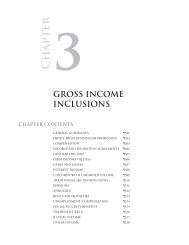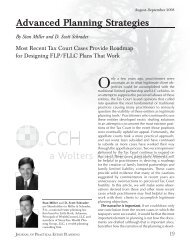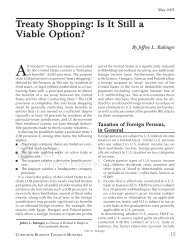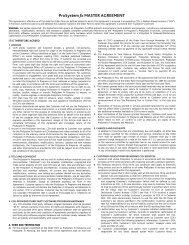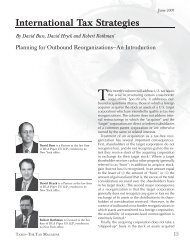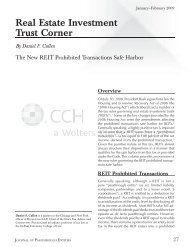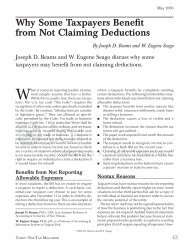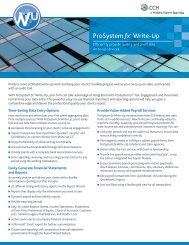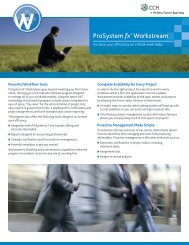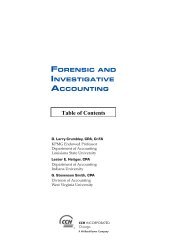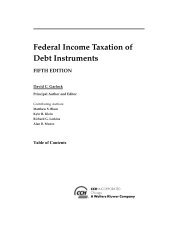The Art of Preparing a Successful Written Protest By William P ... - CCH
The Art of Preparing a Successful Written Protest By William P ... - CCH
The Art of Preparing a Successful Written Protest By William P ... - CCH
You also want an ePaper? Increase the reach of your titles
YUMPU automatically turns print PDFs into web optimized ePapers that Google loves.
How Do I Request a Conferencewith an AO?Because appealing a case is a voluntary process, youmust make a request to have the case heard. <strong>The</strong>re isno filing fee. <strong>The</strong> IRS <strong>of</strong>fers several options for makinga request. For example, you may make an oralrequest for Appeals consideration in (1) all <strong>of</strong>ficeinterview or correspondence examination cases; or(2) a field examination case if the total amount <strong>of</strong>proposed additional tax including penalties, proposedover-assessment, or claimed refund (or, in an <strong>of</strong>fer incompromise, the total amount <strong>of</strong> assessed tax, penalty,and interest sought to be compromised) is $2,500 orless for any taxable period.In these situations, you arenot required to file a writtenprotest. 8On the other hand,taxpayers are requiredto prepare a brief writtenstatement (a formal written<strong>Protest</strong> is optional) toobtain Appeals considerationin a field examination case if the total amount<strong>of</strong> the proposed deficiency exceeds $2,500 butdoes snnotexceed $10,000 for any taxable period. 9Finally, a formal written protest is required in thefollowing owsituations:If thetotal amount <strong>of</strong> the proposed deficiencyexceeds $10,000 00 for any taxable period 10In all employee plan and dexempt emorganizationcases 11In all partnership and S corporation cases 12In some circumstances, you are allowed to makea small case request if the total amount for any onetax period is $25,000 or less by completing IRS Form12203. This form serves as an alternative to the requirement<strong>of</strong> submitting a written protest.<strong>The</strong> IRS may refuse to hear a case on appeal in certainsituations. For example, the Appeals Office willnot hear a case involving a deficiency based solelyon the failure or refusal to comply with the tax lawsbecause <strong>of</strong> moral, religious, political, constitutional,conscientious or similar grounds; and the IRS mayrefuse to hear an appeal where a preliminary review<strong>of</strong> the written protest indicates that it requires furtherwork or development. 13A taxpayer may, <strong>of</strong> course, choose not to requestan Appeals hearing. In this case the taxpayer willreceive a 90-day letter, which allows the taxpayerAppeals Officers come froma variety <strong>of</strong> backgrounds andexperiences. Not surprisingly, theirstyles and the approaches they useto settle tax controversies vary.April–May 2008to file a petition in the U.S. Tax Court. Finally, it isimportant to remember that making a request foran Appeals conference does not stop interest andpenalties from accruing. Interest and certain penaltieswill continue to accrue during the Appealsprocess. Under certain circumstances, you maymake a request to stop the accrual <strong>of</strong> interest andpenalties on proposed adjustments. 14How Long Does theAppeals Process Take?According to the IRS Web site, once you have submitteda written <strong>Protest</strong>, you will usually hear from theapplicable Appeals Office within 90 days. If morethan 90 days have passed,you should contact the<strong>of</strong>fice where you sent theprotest. <strong>The</strong> IRS employeesat this <strong>of</strong>fice should beable to tell you when theysent your case to the AppealsOffice. If, for somereason, they were delayedin sending your protest toAppeals, you should expect to hear from someone inthe Appeals Office not later than 90 days from whenthe protest was forwarded to Appeals. If more than 90days have passed from this date, you should contactthe original <strong>of</strong>fice where your written protest was sentand ask for the name and contact information <strong>of</strong> theAOassigned sigtothe case. Once your protest has beenreceived by yanAO, it generally takes anywhere from90 days to a year to resolve the dispute.What Results Can I Expect from theAppeals Process?If after consideration <strong>of</strong> the case by an AO a satisfactorysettlement is reached between the taxpayerand the government, the taxpayer will be asked tosign Form 870-AD (or a similar agreement formdepending on the circumstances). <strong>By</strong> signing Form870-AD, the taxpayer agrees to waive restrictions onthe assessment and collection <strong>of</strong> any deficiency, andagrees to accept any over-assessment resulting fromthe agreed settlement. 15 On the other hand, if a satisfactorysettlement is not reached, a statutory notice<strong>of</strong> deficiency will be issued. Once this process hasoccurred, the taxpayer has the right to file a petitionwith the U.S. Tax Court for a redetermination <strong>of</strong> thedeficiency. <strong>The</strong> filing must occur within 90 days <strong>of</strong>the mailing <strong>of</strong> the statutory notice <strong>of</strong> deficiency. 16JOURNAL OF TAX PRACTICE & PROCEDURE 39





